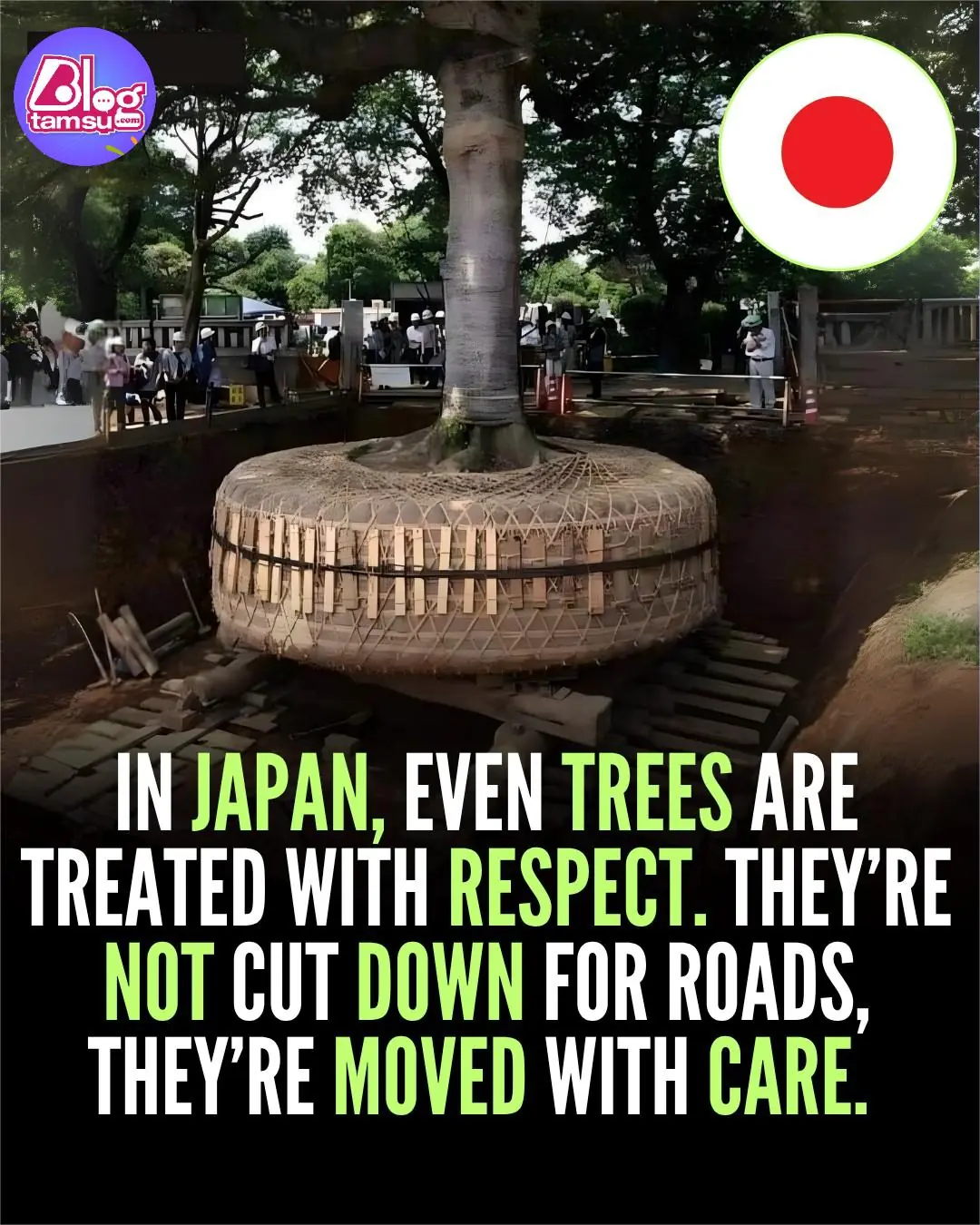
Japan’s Gentle Way of Making Space — Moving Trees Instead of Cutting Them Down

In a world where urban growth often comes at the cost of nature, Japan offers an inspiring example of how modern development can respect life — even that of trees. While in many places road expansion or construction projects mean clearing entire green areas, Japan has mastered an artful and patient alternative: relocating mature trees with great care instead of cutting them down.
A Tradition of Respect for Nature
Deeply rooted in Japanese culture is the idea that nature and people share one living space. This belief has shaped how the country approaches city planning and construction. When possible, instead of destroying decades — sometimes centuries — of growth, engineers and arborists work to preserve it. Large, healthy trees are not simply obstacles to be removed; they’re living beings with history and meaning.
The Ancient Practice of Nemawashi
Central to this approach is a technique called nemawashi — literally “going around the roots.” Before a tree is moved, specialists spend months, sometimes years, preparing it for relocation. They carefully expose and prune the roots, wrap and strengthen them, and treat the tree so it can survive the shock of being transplanted. The soil around the roots is stabilized and kept moist, and when the time comes, powerful cranes and machinery gently lift the entire tree and move it to its new home.
This process isn’t quick or cheap, but it greatly increases the chance of survival. Many ancient temple grounds and urban parks in Japan still hold trees that were relocated decades ago and continue to thrive today.
Why Japan Chooses to Move Trees
There are both cultural and environmental reasons behind this care. Preserving mature trees maintains the ecosystem — birds, insects, and shade all depend on them. It also saves decades of natural growth that can’t be replaced overnight. But beyond ecology, it reflects the Japanese respect for life and history. Some trees stand near shrines or temples and are seen as guardians of the land. Others are rare species or beloved local landmarks.
Urban planners have found that saving iconic trees can strengthen community identity and preserve beauty in neighborhoods undergoing change.
Innovation Meets Tradition
Modern equipment has made it possible to move even massive trees weighing tens of tons. Companies in Japan have specialized vehicles and techniques to support tree relocation for highways, railways, and real estate development. There are also new biological treatments to help transplanted trees recover faster after being moved.
A Global Message of Balance
While not every country can adopt this practice for every project — cost and feasibility remain challenges — Japan proves that development doesn’t have to mean destruction. With careful planning and cultural respect, cities can grow without erasing the life that has long been there.
News in the same category


Man in a Giant Dachshund Costume Steals Hearts Walking His Pet

Trapped in Darkness: How a Chinese Woman Survived 54 Hours in a Snake-Filled Well

The High Price of a Status Symbol: How a Teen’s Kidney-for-iPhone Deal Became a Cautionary Tale

❄️ Brave 11-Year-Old and Her Loyal Dog Save a Mother Goat and Newborn Kid in the Snow

A Young Man’s Act of Kindness Gives an Elderly Neighbor Comfort in Her Final Days

Running Through Grief — A Father’s Marathon of Love and Memory

The Moon and Saturn Meet — October 5

Pick A Bread To See What Kind Of Woman You Are

Zeus the Blind Owl — A Tiny Survivor With a Universe in His Eyes

Uber Will Soon Let You Book Helicopter Rides — A New Era of Urban Travel

From a Lost Check to a Life Rebuilt: The Remarkable Story of Elmer Alvarez

The Rickshaw Driver Who Changed Hundreds of Young Lives

Italian Angler Lands Colossal Catfish That Could Set a New Record

Tiny Hydropower Innovation Sparks Big Energy Dreams in Germany

A Small Miracle: “She Peed, and We Both Cried”

Brave Mother Dog Crosses Danger to Protect Her Puppy

Antimatter: Why the Universe’s Rarest Material Could Be Worth Trillions

Lion With “Bangs” Goes Viral in China — But Zoo Denies Any Haircut
News Post

3 Unusual Neck Signs That May Warn of Cancer

Eat THIS to Get Rid of Swollen Legs & Feet – Incredibly Fast!

Rice Rose Water Collagen Gel: For Flawless Glowing Skin

Eliminate Joint Pain for 20 Years with This Simple Trick!

Papaya Leaves: The Secret to Thicker, Faster-Growing Hair

Discover 12 Super Foods to Enhance Blood Circulation in Your Legs

5 Herbal Teas to Naturally Support Blood Flow and Circulation

The Onion Antibiotic: A Powerful Natural Remedy for Cough, Bronchitis, and Pneumonia

9 Powerful Ways to Use Vaseline for Beautiful Skin

Japan’s Hybrid Coastal Defense: Engineering and Nature Working Together

The Gentle Side of the King: How Lions Pretend to Be Hurt to Teach and Empower Their Cubs

The Surprising Health Benefits of Purple Onion

Moringa: The Miracle Tree That Transforms Your Health

8 Reasons To Leave A Purslane Weed Growing

Unbelievable! Restore Your Vision Naturally with This Parsley Drink!

Rice Baby Oil Collagen Cream: Young Looking Wrinkle Free Skin

Man in a Giant Dachshund Costume Steals Hearts Walking His Pet

Powerful Cure to Cleanse the Lungs & Sinuses – Breathe Instantly with Horseradish!

Goodbye to Urinary Infections and More: Discover the Benefits of Tradescantia Spathacea
